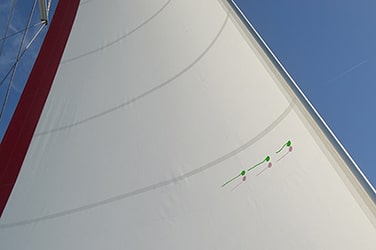
This article is an excerpt from NauticEd’s online FREE Basic Sail Trim Course, an interactive online sailing course for beginner to intermediate sailors to learn the basics of sail trim. Or if you want to learn more, upgrade to the Skipper Course Bundle to become a competent sailor!
You can learn to sail and improve your sailing with NauticEd, the international leader in sailing education.
Best Angle to the Wind when Sailing
Here’s a diagram to show you what “degrees off the wind” means. Assume that the wind is coming from dead ahead of you, sometimes referred to the 12 o’clock direction. If you pointed your hand at 1 o’clock that would be the 30-degree angle off the wind. 2 o’clock is 60 degrees off the wind and 3 o’clock is 90 degrees off the wind.

Figure 1.3-4 Degrees off the Wind
Some very hi-tech ultramodern (and expensive) sailboats like in the latest America’s Cup challengers use wings instead of sails. In the bonus Module 5, we’ll discuss wing sails in more depth because it gives an in-depth knowledge of the forces at work. When you understand those forces you’re getting the real hang of sail trim.
Sails, unlike wings, get their shape from the wind pressure against the fabric. After the shape is filled, then and only then does the lifting effect come to bear. Thus some efficiency of the shape is lost in creating the shape itself and so sails can’t fly as close to the wind as a wing. About the best angle of the wind that most sailboats can achieve is 30 degrees. Any less than this and the wing shape of the sail begins to deflate. We have some control over the shape of the sail with halyards, sheets, outhauls, Cunninghams and fairleads, etc. which we discuss in Modules 2, 3, and 4 and in more depth in our full sail trim clinic.
When the sail points too far into the wind it loses its shape formed by the wind and thus its lift. Liken to an airplane wing going completely flat during flight – we’d be doing more than spilling our coffee.
What we are doing then as sail trimmers is constantly imagining a point where the apparent wind is coming from, then flying the sail at its most efficient angle to that wind. We’re making it act as best as possible like a wing – letting it out as much as we can to keep it flying but without collapsing the shape. This collapse begins at the leading edge of the sail. In Module 2 we’ll discuss how to use the telltales to keep the sail trimmed.
What we do find with most sailing students is that there is a tendency to trim the sails in rather than let them out. It’s a common mistake that comes from not understanding the theory of lift and believing that the sails are pushed by the wind. While in downwind headings, sails ARE pushed by the wind, that is only due to rigging constraints. Module 5 discusses this.
OK, so that’s the basics – apparent wind, lift, and smooth airflow. Here’s a short test to make sure you understand the basics then we’ll move on to Module 2 where it gets a bit more tricky.
Learn Basic Sail Trim for FREE...
A FREE 1-2 hour course that teaches how to work with sails to get your boat moving. The free Basic Sail Trim Course is for any aspiring sailor as well as experienced sailors wanting to learn more. Or, consider upgrading to the Skipper Course Bundle to become a fully competent skipper!
